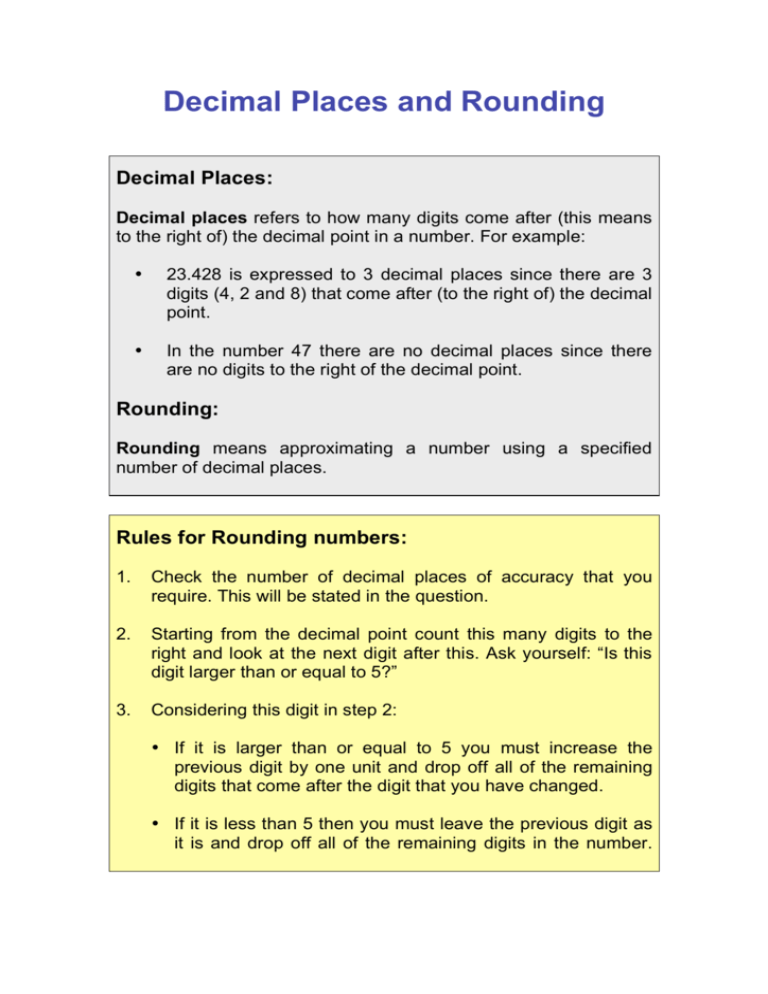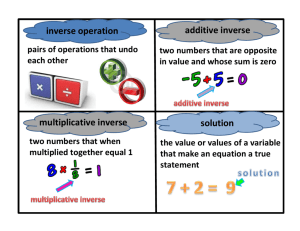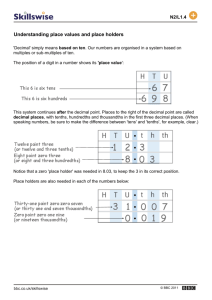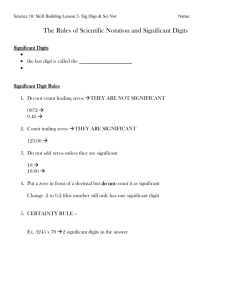
Decimal Places and Rounding
Decimal Places:
Decimal places refers to how many digits come after (this means
to the right of) the decimal point in a number. For example:
•
23.428 is expressed to 3 decimal places since there are 3
digits (4, 2 and 8) that come after (to the right of) the decimal
point.
•
In the number 47 there are no decimal places since there
are no digits to the right of the decimal point.
Rounding:
Rounding means approximating a number using a specified
number of decimal places.
Rules for Rounding numbers:
1.
Check the number of decimal places of accuracy that you
require. This will be stated in the question.
2.
Starting from the decimal point count this many digits to the
right and look at the next digit after this. Ask yourself: “Is this
digit larger than or equal to 5?”
3.
Considering this digit in step 2:
• If it is larger than or equal to 5 you must increase the
previous digit by one unit and drop off all of the remaining
digits that come after the digit that you have changed.
• If it is less than 5 then you must leave the previous digit as
it is and drop off all of the remaining digits in the number.
Example
Write 0.34 correct to 1 decimal place.
1.
You require only 1 decimal place in the final answer.
2.
Count only 1 digit after the decimal point. This is 3. Now look
at the digit after this, which is 4. Ask yourself: ‘Is 4 larger
than or equal to 5?’ In this case it is less than 5 and so:
3.
You must keep the previous digit (which is 3) exactly the
same and then drop off the remaining digits that come after
this 3 (you drop off the 4). The answer is:
0.3
(Expressed to 1 decimal place)
Example
Round 6.856 to the closest whole number
1.
You require a whole number without any digits after the
decimal point.
2.
Look at the digit immediately after the decimal point. This is
8. Now ask yourself: ‘Is 8 larger than or equal to 5?’ In this
case the 8 you are considering is larger than 5 and so:
3.
You must increase the previous digit (which is 6) by one unit
(to 7) and drop off the remaining digits that come after the
decimal point (you drop off the 856). The answer is:
7
(Expressed as a whole number)
Example
Write 32.5647 correct to 2 decimal places.
1.
You require 2 decimal places of accuracy in the final answer.
2.
Starting from the decimal point count 2 digits to the right.
This digit is 6. You must look at the digit after this, which is 4
(and is less than 5).
3.
Since 4 is less than 5, leave the previous digit (the 6) as it is
and drop off the remaining digits that come after the 6 (you
drop off the 47). The answer is:
32.56
(Expressed to 2 decimal places)
Example
Write 58.6398 correct to 3 decimal places.
1.
You require 3 decimal places of accuracy in the final answer.
2.
Starting from the decimal point count 3 digits to the right.
This digit is 9 and the next digit after this is 8.
3.
Since 8 is larger than 5, the previous digit (9) goes up by 1
and becomes 10. This means that the 1 in 10 is carried to
the previous digit (3) to become 4. You must follow this with
a 0 (from the ten). The answer is:
58.640
(Expressed to 3 decimal places)
You must add the final 0 because you were told to express
your answer to 3 decimal places, which means that you must
include 3 digits after the decimal point.
© 2002-2010 IntelliLearn Pty Ltd. All Rights Reserved







